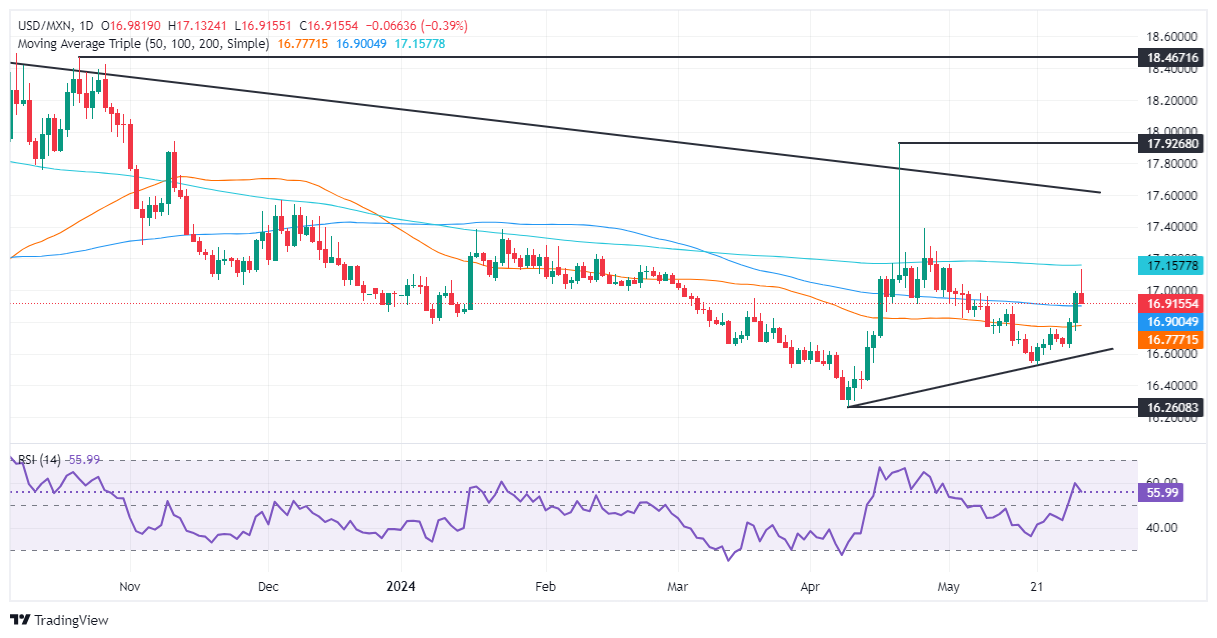For the latest news about the Mexican Peso click here.
- Mexican Peso strengthens to 16.92 after hitting four-week low of 17.13.
- US GDP data unchanged; higher unemployment claims suggest economic slowdown, weakening the US Dollar.
- Banxico revises inflation forecasts upward, hinting at potential split decision on rate cuts in June.
The Mexican Peso (MXN) erased some of its earlier losses against the US Dollar (USD) and rose some 0.20% after GDP data from the United States (US) showed the economy is slowing. Mexico’s economic docket featured the release of jobs data, which came as expected, and an improvement in risk appetite and a softer Greenback are a tailwind for the Mexican currency. The USD/MXN trades at 16.92 after reaching a four-week high of 17.13.
The US Bureau of Economic Analysis (BEA) revealed the Gross Domestic Product (GDP) second estimate for the first quarters, which was unchanged, aligned with the preliminary reading. At the same time, the US Bureau of Labor Statistics (BLS) revealed that the number of Americans filing for unemployment increased compared to expectations, an indication of weakness.
Following the data, US Treasury yields edged lower, while the US Dollar Index (DXY), which tracks the buck’s value against a basket of six currencies, erased Wednesday’s gains, down 0.41% at 104.68. That boosted the Peso, as the emerging market currency retreated below 17.00, strengthening sharply.
Mexico’s National Statistics Agency (INEGI) revealed that the labor market continued to cool down, according to April’s jobs data.
On Wednesday, the Bank of Mexico (Banxico) revealed its quarterly report, in which it revised its inflation forecasts upward. Elevated and stubbornly high inflation has split Banxico’s Governing Council.
Banxico sees headline inflation at 4% toward the end of 2024, up from 3.5% in its previous report. Underlying prices are foreseen to rise from 3.5% to 3.8%.
Banxico Governor Victoria Rodriguez Ceja added that progress in bringing inflation down has been made, adding that it will "assess the inflation outlook as a whole and [...] discuss adjustments to the reference rate at our next meetings.”
Goldman Sachs analysts suggested that the June meeting would be lively. They added, "If a rate cut does materialize, it will likely emanate from a split decision."
Meanwhile, traders brace for the release of April’s Personal Consumption Expenditures Price Index (PCE), the Federal Reserve’s (Fed) preferred inflation gauge. That, along with Mexico’s general election on Sunday, could dictate the USD/MXN path toward the second half of the year as the Mexican currency remains one of the strongest against the US Dollar.
Daily digest market movers: Mexican Peso on the offensive after soft US GDP data
- Mexico’s Unemployment Rate in April came as expected at 2.6%, up from 2.3% in March.
- The latest economic data from Mexico paint a mixed economic outlook. Although the economy continued to grow, higher prices and a widening trade deficit could depreciate the Mexican Peso.
- That and speculation of another Banxico rate cut in June could pave the way for further upside in the USD/MXN.
- May’s Citibanamex poll showed that most economists estimate Banxico will cut rates on June 27 from 11% to 10.75%. The median expects headline inflation at 4.21% and core at 4.07% in 2024.
- US economic docket featured the second estimate of Gross Domestic Product (GDP) for Q1 2024, which dipped from 3.4% to 1.3% QoQ, as analysts expected.
- Initial Jobless Claims for the week ending May 25 rose by 219K, exceeding the consensus 218K and the previous 216K reading.
- Despite that, fed funds rate futures estimated 27 basis points of easing toward the end of the year.
Technical analysis: Mexican Peso appreciates as USD/MXN tumbles back below 17.00
The USD/MXN downtrend remains in play, although buyers gathered steam and pushed the exchange rate toward 17.13, shy of testing the 200-day Simple Moving Average (SMA) at 17.14. Momentum remains bullish, yet buyers are taking a breather after lifting prices close to 3% in three days, trumped by weak US data.
If buyers regain 17.00, that could pave the way to challenging the weekly high of 17.13. Once cleared, the 200-day SMA at 17.14 would be next, ahead of challenging the December 7 high of 17.56, followed by the psychological 18.00 figure.
On the other hand, a bearish continuation would happen if sellers kept the exchange rate below the 100-day SMA, which could pave the way for a dip to the 2023 low of 16.62, followed by the May 21 cycle low at 16.52 and the year-to-date low of 16.25.
Mexican Peso FAQs
The Mexican Peso (MXN) is the most traded currency among its Latin American peers. Its value is broadly determined by the performance of the Mexican economy, the country’s central bank’s policy, the amount of foreign investment in the country and even the levels of remittances sent by Mexicans who live abroad, particularly in the United States. Geopolitical trends can also move MXN: for example, the process of nearshoring – or the decision by some firms to relocate manufacturing capacity and supply chains closer to their home countries – is also seen as a catalyst for the Mexican currency as the country is considered a key manufacturing hub in the American continent. Another catalyst for MXN is Oil prices as Mexico is a key exporter of the commodity.
The main objective of Mexico’s central bank, also known as Banxico, is to maintain inflation at low and stable levels (at or close to its target of 3%, the midpoint in a tolerance band of between 2% and 4%). To this end, the bank sets an appropriate level of interest rates. When inflation is too high, Banxico will attempt to tame it by raising interest rates, making it more expensive for households and businesses to borrow money, thus cooling demand and the overall economy. Higher interest rates are generally positive for the Mexican Peso (MXN) as they lead to higher yields, making the country a more attractive place for investors. On the contrary, lower interest rates tend to weaken MXN.
Macroeconomic data releases are key to assess the state of the economy and can have an impact on the Mexican Peso (MXN) valuation. A strong Mexican economy, based on high economic growth, low unemployment and high confidence is good for MXN. Not only does it attract more foreign investment but it may encourage the Bank of Mexico (Banxico) to increase interest rates, particularly if this strength comes together with elevated inflation. However, if economic data is weak, MXN is likely to depreciate.
As an emerging-market currency, the Mexican Peso (MXN) tends to strive during risk-on periods, or when investors perceive that broader market risks are low and thus are eager to engage with investments that carry a higher risk. Conversely, MXN tends to weaken at times of market turbulence or economic uncertainty as investors tend to sell higher-risk assets and flee to the more-stable safe havens.
Information on these pages contains forward-looking statements that involve risks and uncertainties. Markets and instruments profiled on this page are for informational purposes only and should not in any way come across as a recommendation to buy or sell in these assets. You should do your own thorough research before making any investment decisions. FXStreet does not in any way guarantee that this information is free from mistakes, errors, or material misstatements. It also does not guarantee that this information is of a timely nature. Investing in Open Markets involves a great deal of risk, including the loss of all or a portion of your investment, as well as emotional distress. All risks, losses and costs associated with investing, including total loss of principal, are your responsibility. The views and opinions expressed in this article are those of the authors and do not necessarily reflect the official policy or position of FXStreet nor its advertisers. The author will not be held responsible for information that is found at the end of links posted on this page.
If not otherwise explicitly mentioned in the body of the article, at the time of writing, the author has no position in any stock mentioned in this article and no business relationship with any company mentioned. The author has not received compensation for writing this article, other than from FXStreet.
FXStreet and the author do not provide personalized recommendations. The author makes no representations as to the accuracy, completeness, or suitability of this information. FXStreet and the author will not be liable for any errors, omissions or any losses, injuries or damages arising from this information and its display or use. Errors and omissions excepted.
The author and FXStreet are not registered investment advisors and nothing in this article is intended to be investment advice.
Recommended content
Editors’ Picks

Gold trades near record-high, stays within a touching distance of $3,100
Gold clings to daily gains and trades near the record-high it set above $3,080 earlier in the day. Although the data from the US showed that core PCE inflation rose at a stronger pace than expected in February, it failed to boost the USD.

EUR/USD turns positive above 1.0800
The loss of momentum in the US Dollar allows some recovery in the risk-associated universe on Friday, encouraging EUR/USD to regain the 1.0800 barrier and beyond, or daily tops.

GBP/USD picks up pace and retests 1.2960
GBP/USD now capitalises on the Greenback's knee-jerk and advances to the area of daily peaks in the 1.2960-1.2970 band, helped at the same time by auspicious results from UK Retail Sales.

Donald Trump’s tariff policies set to increase market uncertainty and risk-off sentiment
US President Donald Trump’s tariff policies are expected to escalate market uncertainty and risk-off sentiment, with the Kobeissi Letter’s post on X this week cautioning that while markets may view the April 2 tariffs as the "end of uncertainty," it anticipates increased volatility.

US: Trump's 'Liberation day' – What to expect?
Trump has so far enacted tariff changes that have lifted the trade-weighted average tariff rate on all US imports by around 5.5-6.0%-points. While re-rerouting of trade will decrease the effectiveness of tariffs over time, the current level is already close to the highest since the second world war.

The Best brokers to trade EUR/USD
SPONSORED Discover the top brokers for trading EUR/USD in 2025. Our list features brokers with competitive spreads, fast execution, and powerful platforms. Whether you're a beginner or an expert, find the right partner to navigate the dynamic Forex market.
